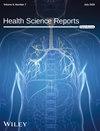Validation of a Scientific Authority Questionnaire for Faculty Members in Medical Science Universities: A Cross-Sectional Study in Iran
Abstract
Aim
The aim of this study was to validate the Scientific Authority Questionnaire (SAQ) from the perspective of faculty members in medical science universities in Iran, as they are entrusted with the responsibility of obtaining scientific authority in universities.
Design and Methods
In this cross-sectional study, multivariate factor analysis was used to assess the factor structure of the SAQ. The study included 379 faculty members of Iranian medical science universities in the fourth planning region in 2023, and the research instrument was a 17-item SAQ. Explanatory factor analysis (EFA) with principal component analysis (PCA), promax rotation, and Kaiser index was performed to evaluate the factor structure of the questionnaire. Confirmatory factor analysis was performed to confirm the EFA. Cronbach's alpha coefficient and intra-scale correlation were used to measure internal reliability.
Results
The EFA and CFA results confirmed that the SAQ contained three factors and 17 items. The content validity of the items was high, as shown by the face validity results (CVR ≥ 0.81, I-CVI ≥ 0.84). Three principal components explaining 70.46% of the variance were obtained after PCA with promax rotation according to Kaiser criterion and eigenvalues. The principal indices in CFA were higher than 0.9, indicating a good fit of the model. In addition, the reliability of the SAQ was confirmed with a Cronbach's alpha of 0.95 and a test-retest reliability of 0.81.
Patient or Public Contribution
No patients or the public were involved in this study.
Conclusion
The SAQ is a contextually relevant, reliable, and valid tool for assessing faculty members' scientific authority. The results of the study suggest that universities need to strengthen their links with industry to build scientific authority. Nevertheless, the instrument needs further development to improve its robustness and address potential limitations. Psychometric studies should be conducted with new populations to ensure the applicability of the SAQ in different contexts.

 求助内容:
求助内容: 应助结果提醒方式:
应助结果提醒方式:


